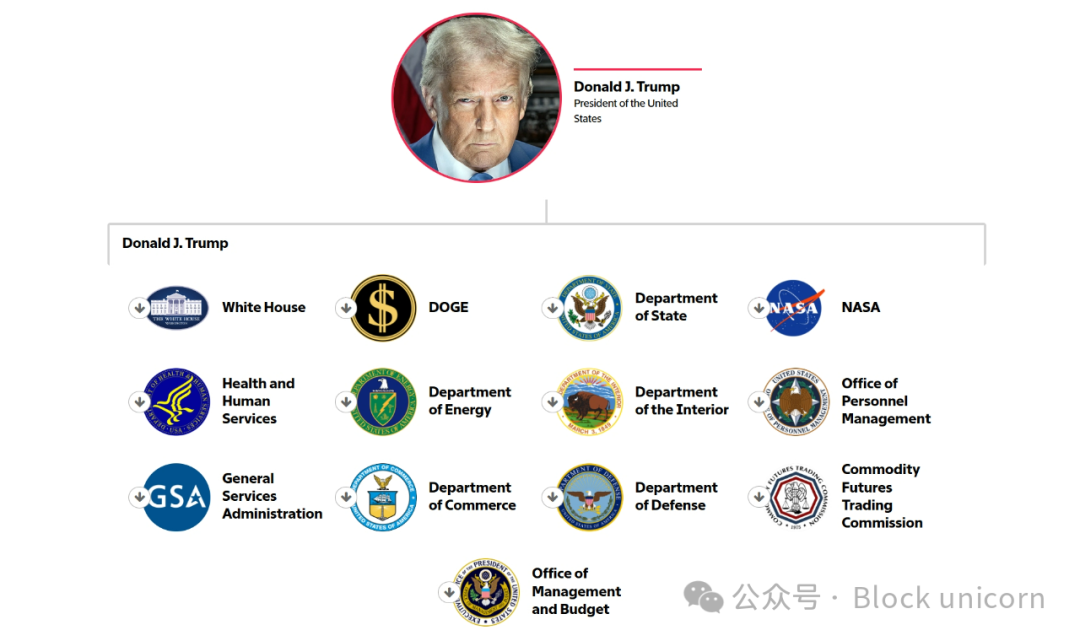Many of the Trump administration’s technical appointees and advisers are important contributors to its campaign, including Musk, Mark Anderson, Jacob Helberg and David Sachs.
Article by Julia Black
Article compiled by: Block unicorn

Foreword:
- Several Trump administration appointees in the technology field have served in previous presidential administrations, including Michael Krazios (Donald Trump’s first term), Abel Sutton (Donald Trump’s first term) and Jim O’Neill (under George W. Bush).
- Elon Musk’s government efficiency department recruited former employees from Musk’s company, some as young as 19.
- Many of the Trump administration’s technical appointees and advisers are important contributors to its campaign, including Musk, Mark Anderson, Jacob Helberg and David Sachs.
Silicon Valley is invading Washington
So far, much of Silicon Valley’s “incursion” into Washington has focused on how Elon Musk and his company’s group of young technical experts scouting the federal government for waste. However, employees from other Silicon Valley companies also play important roles in the Trump administration.
In fact, you could almost call this government the “A16Z government.” Our organizational chart shows more than 24 top technical experts on Trump’s team, including four current or former A16Z partners, who hold formal or informal roles in the Trump administration. This includes co-founder Mark Anderson, who is an adviser to the government’s efficiency unit led by Musk, and Scott Cooper, who serves as director of the Office of Personnel Management.
Trump plans to nominate Brian Kuntenz, policy head of A16Z’s crypto team, to lead the Commodity Futures Trading Commission, Kuntenz posted on X Wednesday morning. At the same time, the company’s Jamie Sullivan is also assisting the government’s efficiency department, while former A16Z partner Sri ram Krishnan is an artificial intelligence consultant to the White House. According to several people familiar with the matter, A16Z’s influence in the government is so deep that members of its talent team are helping recruit government employees.
The company’s participation once again highlights the sharp rise in high-tech influence on the U.S. government over the past month. This is particularly evident compared to Trump’s first term as president, when he openly clashed with the technology industry over issues such as immigration and content censorship.
But as his re-election campaign moves forward, Trump has begun to show that his interests are increasingly converging with those of Silicon Valley-including funding large artificial intelligence projects, deregulation of the crypto market, overhauling defense procurement and reducing red tape for biotechnology entrepreneurs.
At the forefront are employees of Musk and his government efficiency division, who shuttle between federal agencies and their technology systems, conducting comprehensive audits and recommending layoffs. Musk’s deputies-including Steve Davis, Jayne Barahadia and Amanda Skyers-have withdrawn from the day-to-day work of The Boring Company and xAI to assist the government’s efficiency department.
Of course, running the country at the speed of a start-up means Musk and his team ignore questions about conflicts of interest, handling sensitive private data, and even the legitimacy of their actions. On Tuesday, Musk appeared with Trump in the Oval Office, and the president signed an executive order consolidating the responsibilities of the government’s efficiency department.
When asked by reporters about potential conflicts that could arise from his numerous business interests, Musk did not answer the question, but responded: “All our actions are transparent to the greatest extent possible.” In fact, I don’t know of any organization that is more transparent than the efficiency department of government.”
There are signs that more people from the technology industry will continue to join the federal government. Last week, the Office of Personnel Management issued a memorandum announcing the redesignation of senior administrative services and chief information officer positions from career positions to political appointments. The change could open the door for these positions to non-traditional candidates from the technology and business sectors.
A16Z is not the only investment company that has left a mark on the government. The 8VC, founded by Palantir co-founder Joe Lonsdale, is drafting policy memoranda, such as a recent health care report, that appear to be the blueprint for the new administration. And Peter Teal’s series of investment companies have become “gilded schools” for senior officials, including Vice President J.D. Vance.
There are already signs that some technology and business figures may not remain in government positions for long. Entrepreneurs including Vivek Ramaswamy and Loom co-founders Shahid Khan and Vinai Shiremat all left within weeks of joining the government’s efficiency department.
Currently, some technical experts have expressed excitement at their sudden mastery of government power. Early Roblox employee John Shedletsky recently summarized this sentiment on X: “Silicon Valley built the modern world. Why can’t we control it?”



